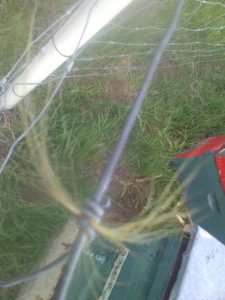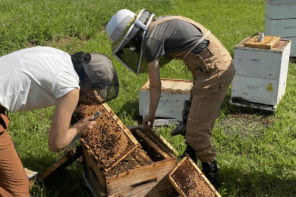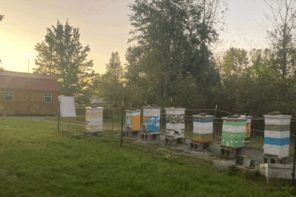A Persistent Bear
Ed Colby
That bear keeps coming around. She hasn’t gotten past the fence around the bee yard, yet. But she’s intrigued.
First she left a tuft from her lovely blonde coat on a barb on the strand of wire above a solar-electrified, four-foot-high, woven-wire fence. See photo.
The barbed wire operates in two ways: First, bears hate it. (I hate it, too. That stuff will bite you!) Second, it’s connected to the ground rod in the fence charging system. If Ms. Bruin puts a paw on the barbed wire above the electric fence and then touches the fence with another paw, she forms part of an electrical circuit from hot to ground, which for her is not so good.
Today the fence was pushed down, as if she’d tried to go over it but then changed her mind.
She destroyed a couple of hives in this yard last Fall. I had to raise hell with the local wildlife officer to get the $260 per hive compensation to which I am entitled under Colorado law. Some bureaucrat in the chain of command said no, based on a technicality, and I had to make a stink to get these public servants to actually read the statute and see things my way.
The gal Marilyn says we never do anything fun, so last week I took her to some primitive hot springs over by the dump. That’s where we met Madison, a engaging young woman finishing up her PhD dissertation on ants at the University of California Riverside. Imagine my surprise when she informed us that she’d been hired by the brilliant and charismatic Dr. Samuel “Sammy” Ramsey at the University of Colorado to study honey bee parasites. Ramsey first got the scientific bee community’s attention when he discovered that Varroa mites feed on bee fat bodies, not bee blood. Now he’s doing groundbreaking research in Thailand on tropilaelaps honey bee mites, and Madison gets to go with him. Lucky girl!
There she was, – Madison Sankovitz – sitting in a pool of stinky water by the dump, and we got to meet her! She just landed a dream job and still has her whole life in front of her. I felt a twinge of envy.
I write to you in July. My little darlings got off to a pathetically slow start. Strong colonies did all right and made some honey off dandelions and the first cutting of alfalfa. These were hives that never got divided in April. I split most colonies in the Spring. Always have. This cuts the mite load in half, creates new hives, and dramatically reduces a colony’s inclination to swarm.
But I no longer send bees to California to pollinate the almonds, so they’re not bustin’ out of their boxes in late March like they used to. Now when I divide my hives, or pull nucs out of them, I’m working with generally weaker colonies. When my splits got on May’s dandelion honey flow, most simply weren’t strong enough to get much benefit from it. Meanwhile, those colonies that had been too weak to divide, but were still stronger than my splits, exploded with honey and population increase.
So I found, side by side in the same yard, powerful colonies with old queens that prospered, and weak ones, many with new queens, that struggled to get going. The rich thrived, while the poor barely made the rent.
I grappled with this at 3 a.m. the other night. I turned ideas in my head, occasionally dozing off, but always coming back to my problem – how do I produce strong Spring colonies with new queens that won’t swarm? Because too-strong Spring colonies headed by old queens will surely swarm. And while swarming might be the bees’ way to generate new colonies, it’s not the beekeeper way.
Finding and replacing old queens in strong colonies is a project. Then you have to get that powerful colony to accept a new monarch and not kill her. I’m not saying you can’t do it, but I’m looking for a better way to get new queens to head strong colonies. It has to be easy, or I’m not interested.
I pondered Gene Killion’s 1950s recipe for making single-story comb honey hives. You confine a new queen to one brood box below a queen excluder and fill that box with brood and bees. You give those bees no space to expand their brood nest and nothing to do with their time but go up through the honey excluder and make comb honey.
That new queen, crammed into one brood box with all her brood nest partners, will not swarm, Gene repeatedly assures us.
I’ve seen this work. Just this Summer I watched one-story colonies fill super after super with comb honey.
Why not try this for extracted honey production as well? It’s a proven comb honey producer. A restricted brood nest ought to help reduce Varroa mite increase, and in my limited experience, I’ve not had runaway mite numbers in single-brood-chamber comb honey colonies. One obvious downside: Come Fall, you’d have to figure out how to overwinter these single-story hives.
When I headed out of town at 6 a.m. after my restless night of mental hive manipulations, I still had bees on the brain. About 7:30, my mind cleared. I had it all figured out.










